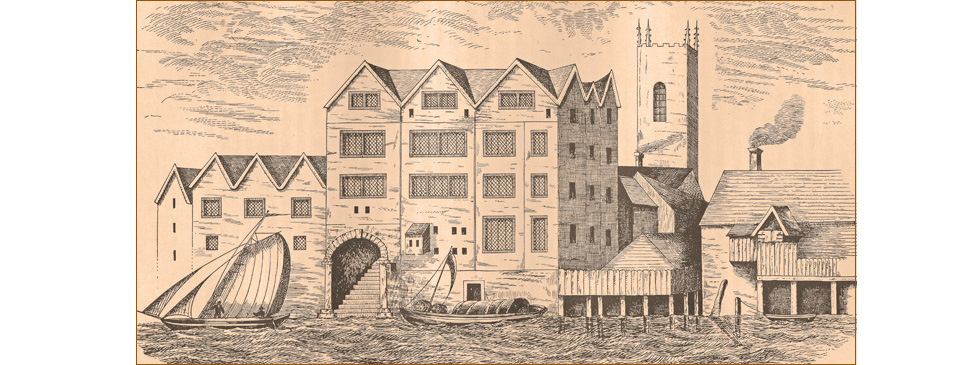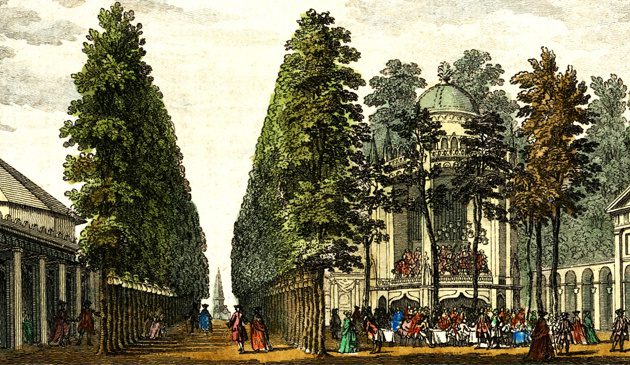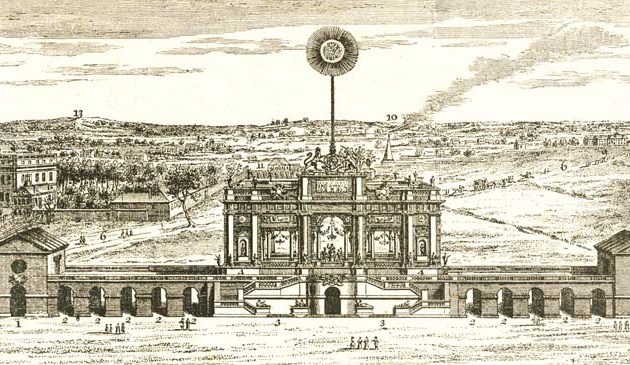Thames watermen and ferries

The earliest mention of the first Hall of the Company of Watermen was in 1603. At the time of this view of 1647 it was located at Cold Harbour, to the east of the modern Charing Cross, a mansion that had been acquired from Earl Gilbert. It was destroyed in the Great Fire of 1666 along with the Company’s records. The Company moved to the present Hall at St. Mary at Hill, upon its completion in 1780.
For centuries, the quickest and most convenient way to travel within the City, or cross the river, or east or west from London, was by water. London Bridge was the only dry crossing over the River Thames in the immediate London area until the early 18th century but it was narrow and congested. The roads into and out of the capital were in a poor state. It was easier to take a ferry, or a wherry rowed by a waterman. The Thames was London’s highway.
After the old Roman roads decayed, goods were thereafter transported by pack-horse. Personal travel was undertaken on horseback or on foot until the mid-18th century. Carriages only began to appear on London’s streets from the mid-16th century but were soon causing congestion. Heavy goods, such as grain or coal, reached the capital by barge or ship.
In his A Survey of London, published in 1598, John Stow stated:
there pertaineth to the cities of London, Westminster, and borough of Southwark, above the number, as is supposed, of 2000 wherries and other small boats, whereby 3000 poor men, at the least, be set on work and maintained.
That was at a time when London’s population stood at around two-hundred thousand.
Wherries could be hired at many stairs that led down to the Thames. Watermen gathered at each, jostling for custom, crying “oars oars sculls oars oars”. ‘Long ferries’ transported passengers along the river, such as from Billingsgate to Greenwich. Working a passenger wherry, ferry, or barge on the Thames in all weathers and tides required knowledge and skill, with tides used to achieve remarkably quick journeys up and down river. The men who operated such craft, as well as those who transported goods by barge or lighter, were a special breed, whose families undertook the same work for generations.
By the Tudor period there were royal palaces along the river at Windsor, Sheen, Hampton, Westminster, Bridewell (on the west side of London), the Tower of London, and Greenwich. They were sited on or close to the riverside because royal barges could quickly and relatively easily transport the monarchs and their servants between them. Similarly, many of the nobility and senior clerics kept palaces fronting onto the river. All these wealthy people, as well as many of London’s Livery Company’s, owned extravagant barges and employed a retinue of watermen to steer them.
There were regular ferry services at various points, which could transport horses and wagons as well as pedestrians across the river. An example was the Lambeth Horseferry between the Palace of Westminster and the Archbishop of Canterbury’s Lambeth Palace. The Woolwich Ferry was mentioned in a document of 1308. It became increasingly important with the establishment of Henry VIII’s dockyards at Woolwich and the Royal Arsenal ordnance depot. The Tilbury to Gravesend ferry that links Essex to Kent has ancient origins. When the Prince of Wales (later King Charles I) crossed on it incognito with the Duke of Buckingham in 1623 they lacked small change for the fare. They attempted to pay with a gold piece but the ferryman had them arrested as spies. Ferries were a lucrative and valuable business usually owned by the Crown or an aristocrat and were part of an inheritance. The ferry owner then leased the right to operate the ferry to a ferryman. Occasionally the rights to a ferry service were sold on, each time for large sums of money.
Whenever a bridge was proposed there was a petition against it from watermen and the ferry-owner and that was one of the reasons London Bridge remained the only crossing until the early 18th century. If a bridge was built, large amounts of compensation were paid by the bridge owner to the Watermen’s Company to be distributed to its members, and perhaps to a ferry owner. The opposite was the case at Chelsea. The ferry there required considerable skill from the ferrymen due to the river current. In 1766 the local inhabitants of the growing villages of Chelsea and Battersea petitioned the House of Commons complaining of the danger and inconvenience of the ferry. The owner, Earl Spencer, decided he could make more money from a toll-bridge, leading to the construction of Battersea Bridge.
A ferry service between the City and Southwark dated back before the building of the medieval London Bridge. One of London’s many legends is that the ferry was inherited by Mary Overs on the death of her ferry-operator father John. It is said she was so overcome with grief when her lover died that she used the income from the ferry to establish a convent. She was canonised, and the convent became known as St. Mary Overy, which is today’s Southwark Cathedral.
The narrow arches and piers of the medieval London Bridge held the river back, acting as a weir. It was dangerous to take a boat under the bridge when the tide was flowing but it was the speciality of some watermen to ‘shoot the bridge’, resulting in regular drownings. Those wishing to travel along the river normally disembarked at a stairs, travelled past the bridge on foot, and took a new wherry or barge on the far side. Typically, the stairs at Three Cranes Wharf (above the bridge) and Billingsgate (below) were used for that purpose.


